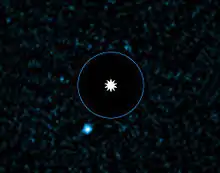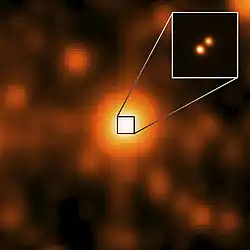HD 95086 b
HD 95086 b is a confirmed,[1] directly imaged exoplanet orbiting the young, 17 Myr [2] A-class pre-main-sequence star HD 95086. It is roughly 5 times as massive as Jupiter and orbits 56–61 AU away from the parent star. It was detected at thermal infrared wavelengths (3.8 μm) through direct imaging, using the NACO instrument on the VLT.[3] A debris disk has been detected in this system at submillimeter wavelengths and has been resolved in the far-infrared from data obtained with the Herschel Space Observatory.[4]
 VLT image of the star HD 95086 and its planetary companion, seen here as a blue smudge. | |
| Discovery | |
|---|---|
| Discovered by | Rameau et al. |
| Discovery site | Very Large Telescope |
| Discovery date | 2013 |
| Direct imaging | |
| Orbital characteristics | |
| 55 – 61 AU | |
| Star | HD 95086 |
| Physical characteristics | |
| Mass | 5.0 ± 2.0 MJ |
| 3.85 ± 0.5 m/s2 (12.6 ± 1.6 ft/s2) | |
| Temperature | 1000 ± 100 |
The planet was initially detected in data taken in 2012 at a separation from the parent star of 623.9 ± 7.4 mas (~56 AU) and position angle of 151.8 ± 0.8 degrees. The planet was recovered at a high signal-to-noise ratio in June 2013. Astrometry for the planet in January 2012 and June 2013, and from a marginal detection in March 2013 confirm that it is bound to the parent star, not a background star. HD 95086 b's brightness at 3.8 μm when combined with sensitive upper limits on its brightness at shorter wavelengths [5] is consistent with trends seen for other young, directly imaged planets like those around HR 8799. In particular, the lower limit of its 1.65–3.8 μm color of 3.1 magnitudes excludes background stars and most brown dwarfs.
The host star was considered a highly probable member of the Lower Centaurus Crux star forming region,[6] until tentatively reassigned with probability 71% to Carina association.[7] The star has a mass of 1.6 solar masses making it a late A type star. It is located approximately 90 parsecs away in the constellation of Carina.[8]
HD-95086b is a massive planet that exists at a large orbital radius, therefore it is a viable candidate for a planet that formed close to its host star and was later scattered outwards via gravitational interactions with other massive particles in orbit around the star. In a debris disk, these particles are of the form of other orbiting planets or planetesimals. This scattering mechanism has been investigated for particles of the form of over-dense fluid elements like those found in a protoplanetary disk containing a planet.[9] It has been proposed that scattering events could explain observed massive planets at large orbital radii.
Spatially resolved images of the system from the Herschel Space Observatory [4] show evidence for a possible 2 belt system with a large clearing between the belts, similar to HR 8799. HD-95086b is probably responsible for carving the sharp inner edge of the outer disk, but additional planets in this system occupying the rest of the gap may be a strong possibility.[1]
References
- Rameau, J., Chauvin, G., Lagrange, A.-M., Boccaletti, A., Quanz, S. P., Currie, T., Mawet, D., Girard, J. H., Bonnefoy, M., Kenworthy, M. (2013). "Confirmation of the planet around HD 95086 by direct imaging". The Astrophysical Journal. 779 (2): L26. arXiv:1310.7483. Bibcode:2013ApJ...779L..26R. doi:10.1088/2041-8205/779/2/L26.CS1 maint: multiple names: authors list (link)
- Eric E. Mamajek. "Post-T Tauri Stars in the Nearest OB Association". Retrieved 2002-05-20.
- Rameau, J (2013). "Discovery of a probable 4–5 Jupiter-mass exoplanet to HD 95086 by direct-imaging". The Astrophysical Journal. 772 (2): L15. arXiv:1305.7428. Bibcode:2013ApJ...772L..15R. doi:10.1088/2041-8205/772/2/L15.
- Moor, A.; et al. (2013). "A resolved debris disk around the candidate planet-hosting star HD95086". The Astrophysical Journal. 775 (2): L51. arXiv:1309.1675. Bibcode:2013ApJ...775L..51M. doi:10.1088/2041-8205/775/2/L51.
- Meshkat, T.; et al. (2013). "Further Evidence of the Planetary Nature of HD 95086 b from Gemini/NICI H-band Data". The Astrophysical Journal. 775 (2): L40. arXiv:1309.0543. Bibcode:2013ApJ...775L..40M. doi:10.1088/2041-8205/775/2/L40.
- P. T. De Zeeuw (1998-09-14). "A Hipparcos census of the nearby OB associations".
- The Age of the Carina Young Association and Potential Membership of HD 95086, 2020, arXiv:2011.07083
- F. van Leeuwen. "Validation of the new Hipparcos reduction". Archived from the original on 2013-11-01. Retrieved 2007-08-08.
- R. Cloutier; M-K. Lin (2013). "Orbital migration of giant planets induced by gravitationally unstable gaps: the effect of planet mass". MNRAS. 434 (1): 621–632. arXiv:1306.2514. Bibcode:2013MNRAS.434..621C. doi:10.1093/mnras/stt1047.


